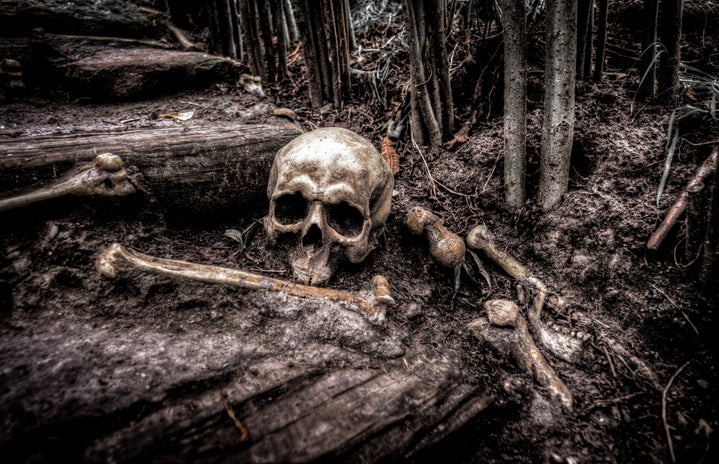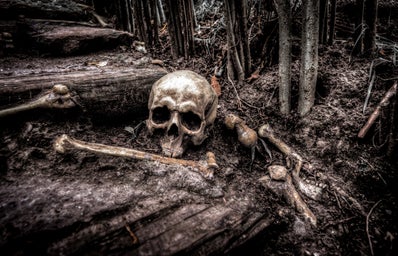What is the scariest form of horror? This is a timeless question that so many others, including myself, have asked time and time again. Some say paranormal, since it summons fear without any physical presence shown. Others say slasher due to their focus on human villains and the brutality shown. However, not all people see horror films the same way. Certain people may find themselves scared of all kinds of horror, while others may only fear one specific type. We all experience fear differently! In this article, I am going to discuss what I believe are some of the most terrifying sub genres of horror. By the time I’m done, I will have given one genre the title of ‘the scariest.’
7. psychological
Psychological horror relies on curating suspense and fear through one’s psyche. By using the audience’s mental and emotional fear, psychological horror is always one step ahead of the viewer. This genre’s films tend to focus on the mental, emotional and psychological states the characters go through to install fear into the viewer. A great example of psychological horror is “The Silence of the Lambs.” Throughout the film, Hannibal Lecter warps Clarice’s mind by using her deep-rooted trauma — the sound of sheep screaming in her uncle’s slaughterhouse. Hannibal’s goal is to deconstruct Clarice’s mind by playing mind tricks on her to learn her deepest secrets. He evokes a psychological fear not only in his opponent but the audience too. Other examples of psychological horror include “Mother!,” “Get Out” and “The Lodge.”
6. SLASHER
Likely the most popular genre listed, slashers are a classic when it comes to horror. But are they the scariest? Slasher films tend to revolve around a serial killer whose sole mission is to hunt down and kill a group of people. This genre is known for its sheer violence and terror, such as “The Texas Chainsaw Massacre” (1974), where every character is chased down by Leatherface at least once. Action scenes like this amp up fear by using the rush of adrenaline viewers get. Between fast-paced chase scenes and painstakingly slow scenes that build-up to the brutal murder of a character, viewers will start questioning the film. Will they escape him? How is he going to kill them this time? The anticipation is enough to get heartbeats racing and blood boiling. Despite many slashers being seen as “campy” today, they are a staple when discussing the variety of sub-genres that come with horror films. Other slasher films include “Friday the 13th” (1980) and “Black Christmas” (1974).
5. GORE
Splatter film, torture porn, whatever you want to call it, gore films are an incredibly controversial genre in the horror community. Regardless of your opinion, gore films primarily focus on the portrayal of explicit violence. Gore movies, closely related to body-horror films, pivot towards the usage of excessive amounts of blood, spilling guts and body trauma. Gore movies are often used to scare the audience by using a shock effect, such as the infamous “Saw” (2004) franchise. In the “Saw” movies, both the characters and audience members are tested on how much they can handle. Both parties are being experimented on — whether it’s how much blood Amanda Young (the well-known character) can shed to stay alive, or how long viewers can stare at the screen until they force themselves to look away. While they are highly debatable when discussing horror in general, there is no doubt that gore films take scaring their audience to a whole other level. A few other splatter films include “Terrifier,” “The Evil Dead” (1981) and “House of 1000 Corpses.”
4. PARANORMAL
Yet another staple when talking about horror films, paranormal horror centers on supernatural elements such as demonic entities, possession, spirits, and ideas that cannot be scientifically explained. Like psychological horror, paranormal films evoke fear in the viewer without any physical presence on the screen. To invoke fear in people without the physical presence of anything being there to scare, is a distinctive talent. The idea of having the possession of a character be something we cannot always see, such as “The Conjuring,” is terrifying. It poses the question of how can you kill something you cannot see? How can something so menacing be so petrifying to the characters and audience? Other films, such as “Paranormal Activity,” use the theme of paranormal in a unique way. These films will use techniques such as doors slamming, figures appearing and strange noises being heard to scare the audience. Paranormal films can mess with the viewer’s mind, almost making them question themselves when it comes to what they really should fear. There is an abundance of other paranormal films, a few examples being “The Exorcist” (1973), “Poltergeist” (1982), and “Insidious” (2010).
3. FOUND FOOTAGE
Found footage horror is where all, or almost all, parts of the film are presented as if they were caught on videotape. The “recordings” tend to be shown in first person, and the point of them are to be “found” by the audience. Found footage tends to be scarier since a lot of the tapes can easily trick the viewer into believing they are real. Found footage films also tend to be scarier due to the more realistic acting and plots used. One example of a found footage movie would be “The Blair Witch Project” (1999). Likely the most famous found footage horror film, “The Blair Witch Project” follows three film students who travel to a small town to document the legend of the Blair Witch. The movie is entirely made up of low quality, off-putting video tapes that get progressively more eerie as the film goes on. The idea of us as the audience being the ones who have found such tapes of the presumed dead trio is extremely dark and grim. You can watch more found footage films such as “Creep,” “The Taking of Deborah Logan,” and “V/H/S” (2012) to get an even deeper dive into the sub-genre.
2. MONSTERS
Here we have yet another classic in the horror genre, monster horror. Monster horror scares its audience by using monsters as their main villain. Having strange creatures wreak havoc in towns and people amps up the action even more, especially when you take into consideration the variety of monsters that exist. Werewolves, vampires, aliens, mutants and supernatural beings are all examples of monsters historically used in horror. In monster movies, the beasts tend to have menacing fangs and claws, a set of bloodthirsty goals, and are much stronger than any average antagonist or villain. However, some monster movies use real animals as their villains. Films such as “Jaws” (1975), “Cujo,” and even “Jurassic Park” (1993) are categorized as monster movies since the antagonist is an animal or beast. Monster movies in general are horrifying simply because they are unlike anything most audiences are used to. Most horror films have humans that are villains, so seeing such a drastic change can be alarming. Realistically, a serial killer like Jason Voorhees could potentially be on the loose, but a deranged dog or fish-like monster? Pretty unrealistic. The fear of the unknown is a terrifying concept and plays its role perfectly when talking about the sub-genre that is monster horror. Some other monster horror movies include “The Thing” (1982), “Fright Night” (1985), and “An American Werewolf in London.”
1. HOME INVASION
And finally, the last sub-genre I will be diving into today is home invasion horror. Home invasion plots in horror films take the term ‘horror’ to a whole new level. You are toeing the line of public and private spaces, meaning the distinction between the two is slowly colliding together. The idea of one or more intruders breaking into your home is already terrifying enough. To bring that concept to the big screen and make it seem exceptionally realistic is even scarier. Home invasion films install a new sense of fear into the viewer, and that is why it is the most terrifying form of horror out there.
Home invasion films have the most realistic plots any horror film could have. Since monsters and paranormal entities are not real, and few serial killers are on the loose right now, it is safe to say that the plot of a home invasion is more likely to happen than any other sub-genre. Home invasion horror is so appalling because it could happen to anyone. No matter how safe you think you are, there will always be some chance of someone breaking into your home. Home invasion horror proves just how dangerous the real world can be. The movie “The Strangers” (2008) is a perfect example of home invasion horror. What started out as a peaceful getaway at their vacation home, soon turned into a night of terror and the main couple struggling to survive after a trio of masked intruders break in. When the main character, Kristen, asks the intruders why they are doing this, the masked blonde replies, “Because you were home.” This line alone is chilling and answers the question of why home invasion horror is so scary. While there are countless other types of sub-genres in horror we could pick apart and debate, I believe that my point stands strong. Between its sheer realism and likeliness, home invasion horror takes first place when discussing the scariest form of horror. For this upcoming Halloween, I’d recommend the films “Funny Games” (1997), “Don’t Breathe,” “The Collector,” and “You’re Next” are more home invasion films to watch.


